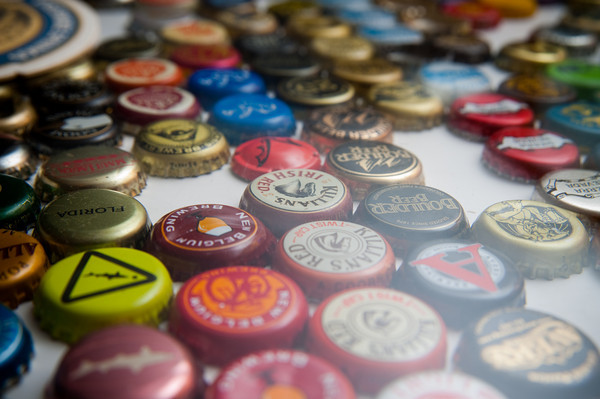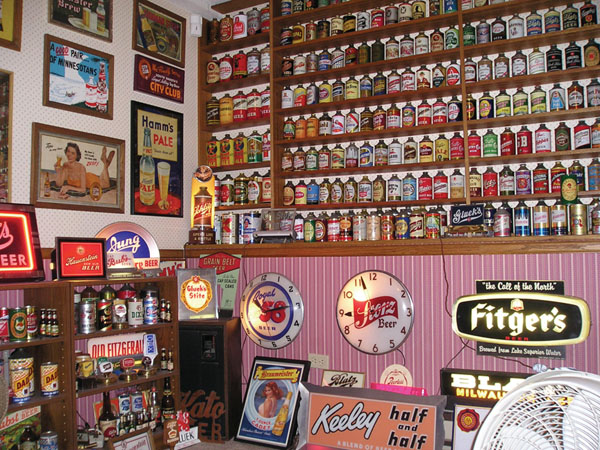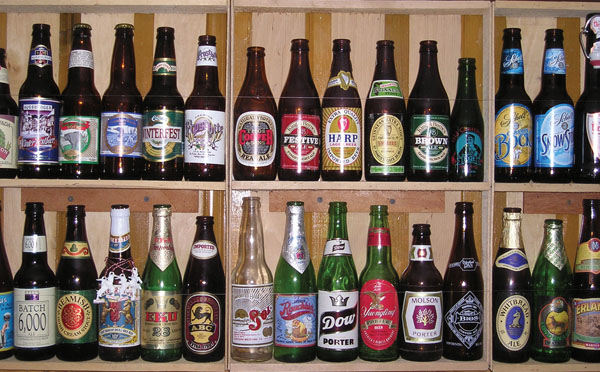
It usually starts innocently. While having a new beer or two with friends, you pick up a coaster, a bottle cap or a bottle with a colorful label, perhaps as a reminder of good times while on vacation. Maybe you bought a couple of colorful pint glasses at exotic brewpubs, and decided they looked good on the shelf. Or maybe you picked up an old beer sign or light at a garage sale to add the final touch to the party room in the basement. Only it wasn’t the final touch — you found yourself hooked. One coaster multiplied like rabbits to cover an entire wall, the bottle caps covered the bar, and shelf after shelf appeared to display the glasses of all sorts that celebrated your tours to different breweries. And the beer light? You now have so many and use so much electricity that you were personally responsible for that ice sheet that broke off in Antarctica a few years back. You’re a true beer collector.
Why is an article on collecting used and sometimes rusty beverage packaging on a site dedicated to gastronomy? Beer items help us trace the history of one of the world’s oldest drinks from its earliest years as a local business, through massive consolidation and homogenization of the industry and product, to the modern return of craft and regional specialty. That dusty glass from a distant brewery serves as a reminder of past quests for flavor and an encouragement to venture forth again. Finally, collecting is fun. So, on to the show — perhaps literally.
A Short History of Breweriana
Any piece of beer packaging, advertising, or promotional material that features the name of a brewery or a brand of beer can be listed under the somewhat awkward term “breweriana.” The most fundamental use of the brewery name was simply to identify the product and make a claim of ownership to the container. As beer was shipped farther from home, barrels, bottles, and cases were branded, embossed, or labeled to encourage their return to the brewery, which had a substantial investment in these items. The red triangle of England’s Bass Ale is one of the world’s oldest product logos (though it was not trademarked until 1875). One reason that few pieces predate the Civil War is that beer was generally produced for a local market and sold in bulk (by the keg), so advertising brand names directly to the consumer was seldom necessary.
In the 1870s, two major developments paved the way for modern breweriana. The expansion of railroad shipping and business consolidation increased the competition between breweries and made advertising necessary. Furthermore, advances in manufacturing processes and material science made it possible not only to create durable and beautiful items, but also to mass produce them and adapt them to a variety of needs.

Beginning in the late 1870s and early 1880s, brewers began to compete more vigorously to capture both the saloon and household markets. The majority of large advertising items were produced for use in saloons to increase sales of a particular brand of beer and to encourage saloonkeepers to keep buying beer from the same brewery. Outdoor signs helped draw patrons in, and once inside spectacular lithographs featuring outdoor scenes, attractive women, or a view of the brewery brightened the interior. To build up their home trade, breweries offered glassware, calendars, serving trays, sewing kits, paper fans, and dozens of other ornate items designed to keep their brand of beer on customers minds when it was time to order. Many of these smaller items migrated to the back of drawers or cabinets over time, and have only begun to reappear recently.

It is amazing that so many breakable items survived to the present day, or that disposable items were kept at all. It is a tribute to the attractive designs and the tie between beer brands and the public imagination that many large mirrors and signs survived. Items such as pitchers, glasses, and openers were kept around because they were useful (but continued use led to increased chances of breakage).
Of course, all of this came to a sudden end with Prohibition. While a few brewing companies stayed in business making near beer or other products, there was much less reward for advertising as heavily as they did with beer, and no saloons to supply.
Upon repeal, the advertising arms race was on again. The 1930s have become a popular period for collectors because of the number of striking Art Deco pieces and the introduction of neon beer signs. After World War II, television forced most brewers to expand nationally in order to survive the competition. Unfortunately, going national usually meant making the beer less distinctive to appeal to more people. This leads to a general principle of advertising: The more similar the products, the more distinctive the advertising. The most enduring of the ad campaigns from this era was the Hamm’s Bear, who appeared in well-loved TV commercials and on every conceivable souvenir item. Alas, Hamm’s standing among American brewers slipped during the Bear’s reign despite the powerful regional imagery of woods and waterfalls. Beer advertising became like wallpaper — while it may have been attractively designed, it was repetitive and drew little sustained attention.
During this period, collecting beer relics was largely accidental. A few legendary collectors had begun to amass collections of labels or to save a few mementos from the local brewery as it closed for good, but there was little interest from the general public beyond the functional use of an opener or a cooler. One group that collected beer stuff in a more devoted, but often temporary, way — college students. Having a wall full of beer cans in a student apartment served as an advertisement of capacity, and in a few cases, good taste. A few more adventurous students began to seek out cans unique to the region they were passing through on their road trips in a quest to add color and variety to their walls. Of course, these collections usually disappeared upon graduation (or expulsion).
But in the 1970s, two developments led to an explosion of interest in breweriana: the organization of the hobby, and the rise of interest in imported and craft beer. Early in the decade, groups such as the Beer Can Collectors of America and the National Association of Brewery Advertising formed to allow the formerly scattered collectors a chance to meet regularly, swap stories and duplicate items, and begin to organize the historical knowledge accumulated over the years. Breweries were quick to recognize a potential market, and many regional companies such as Pittsburgh Brewing Co. and August Schell Brewing of New Ulm, MN, were able to pay the bills with commemorative cans celebrating everything from Super Bowl champions to small local festivals. Hard as it is to believe today, thousands of grade schools and junior highs once had school-sponsored beer can clubs.
When the craft-brewing revolution began in the 1970s, America’s microbreweries began to produce styles that had been absent for years and to create new styles of their own. At the same time, renewed interest in imported beers brought many long lost styles back to store shelves. Today’s collector can find specialized glassware designed to enhance the aroma and flavor of each style, as well as a huge variety of advertising designed to draw attention to the new brews. Seasonal beers lend themselves particularly well to colorful advertisement, and bock beer has seen a resurgence among both drinkers and collectors (especially since it is no longer the brewery’s regular brand with food coloring added).

As the regional identity of beer and brewing continue to increase in the new decade, more and more people are reveling in the discoveries of new local specialties. Certain breweries have gained reputations for unique beers, and a limited release of a special strong beer like Surly Darkness (Brooklyn Center, MN) or Three Floyds Dark Lord (Munster, IN) will draw crowds from hundreds of miles away seeking a chance to buy a few precious bottles of a rich, thick imperial stout which could improve with age (for those patient enough to wait). For the lucky few, saving the empty bottles is proof of taste and of rare achievement — a few bottles of these is more impressive than an entire wall of Schlitz.
Answering the question “Where do we put all this stuff?” can split a family quicker than you can say “neon.” For a handful of dedicated collectors, every room in the house has some breweriana. However, in most cases the beer items are relegated to a single room in the house — though it must be noted that dozens of collectors have built special shelving or even an addition to their house to display their collection at its best. To paraphrase Denis Leary, beer doesn’t lead to other drugs — it leads to carpentry. Luckily, our contemporary world has created a term for this room: the Man Cave. It’s a much more macho way to refer to an antique collection.

Did your mom throw out all your old cans and beer posters? For those in need of a Man Cave centerpiece, the numerous breweriana shows held throughout the year provide a chance to browse, admire, and even find out what the pieces you already have are worth.
On Saturday, June 12, the American Breweriana Association will end its annual gathering with a large show at the Holiday Inn and Suites at 494 and 34th Ave. in Bloomington. Thousands of items in all price ranges will be available from 8:30am to 2pm. For those unable to attend this show, websites like americanbreweriana.org list shows around the nation. Collectors also set up at many flea markets and other antique shows.
Collecting breweriana is much more than a way to count how many beers one has had. It illustrates advances in technology and changing economic patterns. It shows changing relationships within society and what people cling to in time of change. Breweriana keeps family names alive and celebrates the enterprising spirit of people around the world.
Doug Hoverson is the author of Land of Amber Waters: The History of Brewing in Minnesota. He is also a member of the American Breweriana Association and Associate Editor of American Breweriana Journal, from which portions of this article were adapted by permission.


I own a Glueks shelf light. Can you tell me the value as I am interested in selling it